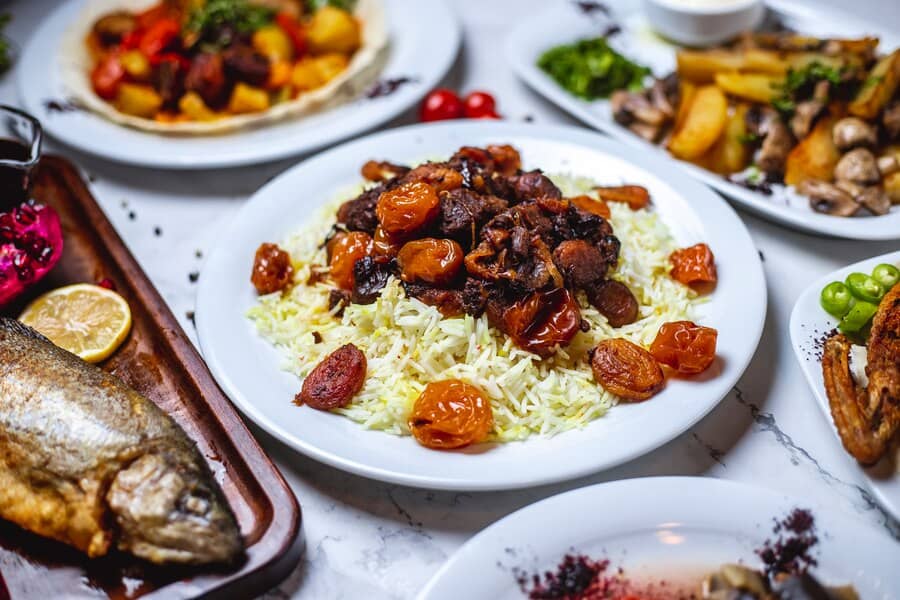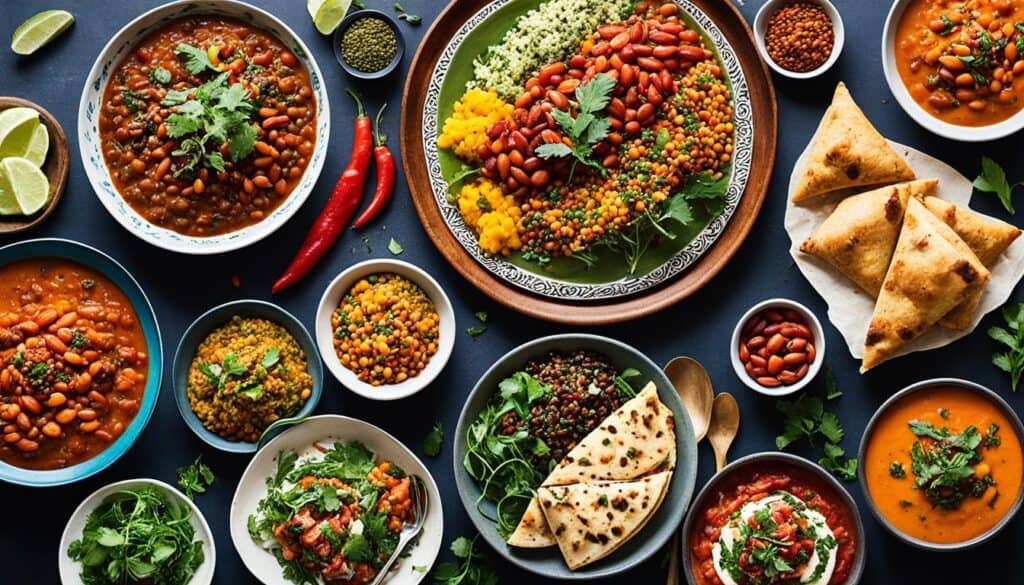
Explore the Rich Diversity of African Food and Cuisine
Sitting in my kitchen, I’m not just smelling the food. I feel like I’m traveling through Africa’s diverse and colorful culinary world.
This continent boasts a rich african food and cuisine. It’s filled with traditional dishes, ethnic recipes, and cultural gastronomy.
Until recently, this amazing food was not well-known. But that’s changing, thanks to chefs like Kwame Ofori.
They are showing the world the incredible regional flavors and culinary heritage of Africa.
From street food in the West to the comforting dishes in the South and the spicy foods in the East, every part of Africa offers something special.
It’s an amazing journey through local tastes and authentic cooking. Such diversity makes African cuisine a true global culinary gem.1
Start your culinary adventure in Africa. Discover the treasure trove of flavors and traditions.

Key Takeaways
- African cuisine is a diverse tapestry of regional flavors and cultural traditions.
- Chefs like Kwame Ofori are leading the way in showcasing the rich culinary heritage of Africa.
- West African cuisine is characterized by a vibrant street-food culture, aromatic spice blends, and comfort-centric dishes.
- African cuisine offers a wide array of indigenous ingredients and sustainable cooking techniques.
- The popularity of African cuisine is growing, with more people discovering its craveable flavors and diverse offerings.
Introduction to African Cuisine
African cuisine brings together unique tastes from a wide, culturally rich area.
It gets its flavors from both old empires and local traditions as well as from global exchanges.
This diverse mix gives rise to meals rich in flavors. With influences from ancient empires, indigenous cultures, and global trade routes,2, African recipes carry a deep and varied history.
From North Africa’s bold spices to Central Africa’s hearty staples, and West Africa’s fragrant mixes – each region has its own special dishes to explore.
Culinary Heritage and Cultural Influences
The culinary heritage of Africa is a blend of many cultures that have mixed over time.2 For example, in North Africa, we see the influence of old empires like Egypt and Morocco.
These lands were quick to use semolina in their famous couscous.2 From every corner of the continent, Middle Eastern, European, and Asian cultures have also shaped African cooking.
The result is a vibrant mix of flavors and styles.
Regional Diversity and Unique Flavors
The richness of Africa is noticeable in the variety of its food.2 West Africa enjoys spicy foods, often featuring ginger and chili pepper. It also uses ingredients like palm oil and tomatoes.2
In East Africa, you’ll find dishes flavored with coconut milk, cinnamon, and cardamom.2 Meanwhile, Southern African meals often include maize, beans, and meat.
This variety is one of the most exciting things about African food – there’s always something new to try.
West African Culinary Delights
West African food is a mix of colorful street eats, fragrant spices, and hearty meals like rice, stews, and soups.3
You’ll find unique tastes and dishes in different parts of the region.
Places like Nigeria, Ghana, and Senegal stand out for sharing their delicious foods with the U.S.4
Vibrant Street Food Culture
The food scene in West Africa is vibrant and exciting, especially on the streets. You can enjoy dishes like the beloved jollof rice and the popular alloco4.
These foods make walking around in West Africa a treat for your taste buds.
Aromatic Spice Blends and Condiments
The soul of West African cooking is in the rich spice mixes. Dishes get their wonderful smells and flavors from these blends, which include ginger, garlic, and hot peppers.
To complement these, you’ll also find tasty extras, like dodo, or fried plantains in Nigerian meals, which add a fun twist to dishes.4
Comfort-Centric Rice Dishes, Stews, and Soups
West Africa is known for its comforting meals, including the famous jollof rice. There’s also garri, a cassava dish that comes in various forms.
The region’s stews and soups are full of flavor, thanks to their mix of spices, veggies, and meat. Eating these meals is truly an enjoyable experience.
Spotlight on Signature Dishes
African dishes are famous for their rich flavors and cultural roots. They include the zesty suya, hearty yassa stew, and the loved jollof rice.
Each dish tells a story through taste.2
Suya: Spiced Meat Skewers and Spice Blend
Nigerian suya mixes skewered meat with a special spice blend. This blend, made of groundnut, ginger, and more, is why it’s so popular worldwide. It shows the tasty creativity of West African cooking.2
Yassa: Senegalese Chicken Stew
Senegal’s yassa stew is a favorite for its bold flavors. It’s made with chicken in a sauce of caramelized onions, mustard, lemon, and ginger. This mix of sweet and tangy flavors makes it a true comfort food.2
Jollof Rice: Tomato-Based Rice Delight
The famous jollof rice is known well beyond Africa. It’s a tomato-based rice filled with flavor from ingredients like onions and peppers.
It reminds some of jambalaya, making it a familiar dish for many.2
African Food and Cuisine: Craveable Flavors
Today, West African african cuisine is winning over many people. It uses rich spices, grains, and cooking methods. These include live fires and slow braises, creating unique dishes.
A lot of their famous meals are plant-based and gluten-free. This matches with current diets and choices. The dishes are full of craveable flavors that make people want more.5
In the U.S., West African food is becoming a top choice. Chefs like McQueen and Adjepong bring these flavors to us. They make it easy to enjoy in places like fast-casual restaurants.
This food’s growth is also thanks to the African diaspora. It blends African traditions with new, creative cooking. This gives birth to amazing dishes loved by many.5
Key flavors everyone loves include suya, yassa, and jollof rice. Suya, with its Nigerian roots, is becoming a hit in the U.S. It’s easy to see why, with its tasty spiced meat on skewers.
Yassa, a Senegalese stew, can also shine without meat. It shows how plant-based cooking can be exciting and tasty. Then, there’s jollof rice, which many Americans enjoy. It’s familiar yet different, much like jambalaya or red rice.5
The beauty of West African food is in its creativity. Chefs are encouraged to put their spin on traditional dishes. This keeps the food scene fresh and exciting.5
As african cuisine becomes more popular, so do its spice blends. Many are now discovering flavors from Africa and beyond. Spice mixes like Ras el Hanout from Morocco and Berbere from Ethiopia are becoming more common.
Younger people especially love knowing where their food comes from. This has made learning about spice blends an important part of marketing. It adds to the appeal of these unique flavors.6
Curries, especially ones like Doro wat, are big hits. They offer new chances for food companies to be creative. Moroccan and Ethiopian foods have a solid place in the U.S. cuisine scene.
However, dishes from places like Egypt and Congo are becoming more popular, too. People are eager to try something new and adventurous. This keeps the food world ever-changing and engaging.6
East African Culinary Journey
When you start exploring East Africa’s food, you find a mix of many flavors and traditions.
Imagine the spice-filled biryani in Kenya’s coastal parts and the fragrant pilau of Zanzibar.
This journey shows the varied and rich cuisine of the region.7
Kenyan Flavors: Biryani and Coastal Delights
Kenyan food is colorful, thanks to over forty different ethnic groups. The coast shines with biryani, a dish filled with fragrant rice and meat or seafood. Coconut milk is often added, showing the impact of cultural mixing and trade.879
Tanzanian Cuisine: Spiced Rice and Zanzibari Influences
Tanzania’s food mixes many flavors, especially those along the coast influenced by Swahili culture.
Dishes like pilau and biryani, as well as fresh seafood, are loved. Across the country, people enjoy ugali and Nyama Choma.
Spices, local ingredients, and a mix of sweet, savory, and spicy tastes define Tanzanian food.9
Zanzibar’s dishes have also gained fame in the region.9
Rwandan Simplicity: Ugali, Beans, and Leafy Greens
Rwandan food is simple and focuses on staple foods like ugali and beans. It also uses greens from the area.
This diet aims to provide simple, locally-sourced, and nutritious food. Though, there have been challenges like meeting vegetable needs, leading to health issues.8
Ugandan Diversity: Matoke, Luwombo, and Street Food
Uganda’s food reflects its many regions and influences. You’ll find matoke, made of green bananas, and luwombo, a steamed meat dish, as mainstays.
The country’s street food is lively with dishes like Rolex and samosas. This diversity showcases Uganda’s rich food scene.7
Plant-Based African Delights
The plant-based African cuisine shows a love for vegan and vegetarian options.10 In West Africa, you’ll find tasty dishes like Lion’s Mane Pie and Grilled Cabbage.
These dishes prove how delicious and versatile plant-based African cuisine can be.10
Also, foods using ancient grains such as fonio are becoming very popular in African-inspired dishes.10
Vegan and Vegetarian Options
The food in West Africa is great for vegan and vegetarian options.10 It’s packed with things like beans, lentils, and lots of nourishing veggies.10
You can enjoy dishes like Green Lentil Bobotie, Red Red, and Smoky Baba Ghanoush.
These meals show off the exciting side of plant-based African cuisine.10
Ancient Grains and Indigenous Ingredients
There’s more to plant-based African cuisine than just vegan and vegetarian options.11 It also uses ancient grains and indigenous ingredients.11
This includes yams, sweet potatoes, and grains like sorghum. These ingredients bring nutrition and rich culture to the table.11
Using these special grains and ingredients makes plant-based African dishes truly authentic and loved by many.1011

Third-Culture Cooking: Fusion and Evolution
The African diaspora has shaped third-culture cooking in a big way. This type of cooking mixes foods from different cultures into something new.12
For example, Chef Mawa McQueen combines her Ivorian roots with flavors from France and beyond.
Her dishes are a bridge between the old and new, celebrating the tastes of Africa with a modern twist.13
Diaspora Communities and Cultural Exchange
Many chefs and writers, thanks to their African cultural roots, are mixing foods from various traditions.13
People like Khushbu Shah and Ozoz Sokoh are telling their tales through food. They’re helping us all learn about the delicious results of cultural blending.
This sharing promotes understanding and respect for each other’s food and stories.
Innovative Interpretations and Fusion Dishes
The pairing of African flavors with global influences is really taking off.12 Chefs are experimenting with new combinations to excite our taste buds.
They’re not doing it alone – working with food makers, they’re bringing these new dishes to our tables.12
Think disto onion rings and wun tun ravioli. These dishes are not just food; they’re stories of cultures meeting and creating something awesome.13
Authentic African Flavors at Home
More people are getting to know African cuisine. Now, it’s easier for cooks to find the right14 ingredients.
They can make authentic15 African meals at home. You can use old recipes or try new ways. Mixing African ingredients with familiar foods is exciting.
It puts Africa’s rich tastes in your kitchen.
Sourcing Ingredients and Spice Blends
In North African food, expect to see olives, olive oil, and preserved butter (smen). Also, look for floral flavors and preserved lemons.
Morocco uses spices like saffron and nutmeg gently. But Algeria and Tunisia use hot spices like harissa.
They add cayenne and aniseed for a kick.14
Traditional Recipes and Modern Adaptations
Trying authentic recipes from Africa is great. But you can also add African twists to your own dishes.
For instance,15FAIDA Hot Sauce brings African heat to everyday foods. It’s loved by many and brings the spirit of Africa to your meals.15
| Spice Blend | Description |
|---|---|
| Ras El Hanout | 14Ras El Hanout is a key spice mix in North Africa. It can have 20-30 spices. This mix is great for flavoring tagines or soups. |
Getting real African ingredients is step one. Then, tweak recipes to make them your own. This way, you get to enjoy the diverse flavors of Africa right at home.
Plus, you’ll make meals that everyone will remember.
Culinary Ambassadors and Rising Popularity
Chefs and restaurateurs are making African cuisine famous in the U.S. Kwame Ofori, Mawa McQueen, Eric Adjepong, Ayo Balogun, and Shenarri “Greens” Freeman lead this movement.
They’re getting African food more popular. More folks are trying and liking its flavors.
This makes African cuisine more recognized and part of the big food scene.
Chefs and Restaurateurs Promoting African Cuisine
Big names like Mawa McQueen, Eric Adjepong, Ayo Balogun, and Shenarri Freeman are pushing West African flavors into American dishes.5
They mix tradition with new ideas, making West African food appeal to many. The influence of people from Africa living elsewhere has also helped.
This is why West African food is finding its place in U.S. food culture.
Growing Interest and Mainstream Acceptance
Many are now interested in West African cuisine. It’s becoming a top choice for new menus.5
Its use of special spices, hearty grains, and unique cooking methods appeal to people. Plus, many dishes fit well with various diets. This further boosts its popularity.
Places like Brooklyn Suya and Ubuntu are making African food easy to try. This is making it more and more popular.5
As more folks taste the amazing variety of African dishes, its fame grows. Dedicated chefs, food lovers, and curious eaters are all part of this.
Thanks to them, African cuisine is gaining a big place in the food world.
Conclusion: Explore the Rich Diversity of African Food and Cuisine
African cuisine is like a world of flavors mixed together. It shows the culture and history of the area.
Plus, it uses what nature gives. With more chefs and people loving these foods, they’re reaching every part of the globe.16
The taste of African dishes is becoming more popular worldwide. This journey through African food traditions is quite exciting.
It’s also a blend of different cultures, especially the African diaspora, creating a unique style of cooking.17
Thanks to recognition like Michelin stars for West African places in London, the future of African food looks bright.
People are turning to these dishes for their health and the environment.
It’s making its way to the top spot, interesting more and more folks around the globe.17
Related read: The-vibrant-world-of-african-music-and-dance-dive-into-the-rhythm-and-soul
Source Links
- https://www.africarebirth.com/exploring-the-delicious-and-diverse-world-of-african-cuisine/
- https://www.mccormick.com/articles/mccormick/the-beginners-guide-to-african-cuisine
- https://medium.com/@gabrielmahia/african-culinary-delights-a-journey-through-the-continents-unique-flavors-59a249cfeb1f
- https://ajojesnacks.com/blog/deliciousness-of-west-african-food/
- https://www.getflavor.com/exploring-west-african-cuisine/
- https://fuchsna.com/blog/african-cuisine-trends-22/
- https://epickitchen.net/east-african-countries/
- https://www.theelephant.info/analysis/2018/02/08/food-and-migration-a-culinary-journey-through-east-africa/
- https://swahiligecko.com/blog/east-african-foods
- https://www.myburntorange.com/category/vegan-african/
- https://westtowestkitchen1.wixsite.com/african-food-recipie/post/vegan-and-vegetarian-delights-african-plant-based-cuisine-in-dubai
- https://in-sight.symrise.com/article/fusion-chaos-and-new-ways-of-crafting-cuisine
- https://www.theglobeandmail.com/life/food-and-wine/article-why-third-culture-cooking-is-less-of-a-trend-and-more-of-a-triumph
- https://www.grocery.coop/food-lifestyle/cooking/flavors-of-north-africa
- https://faidafoods.com/
- https://momaa.org/world-food-day-the-art-of-african-cuisine/
- https://www.itsallgoodsinc.com/insights/how-african-foods-are-shaping-global-food-trends






